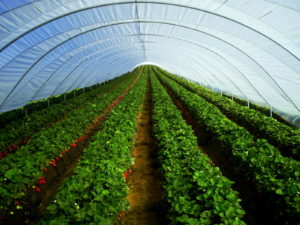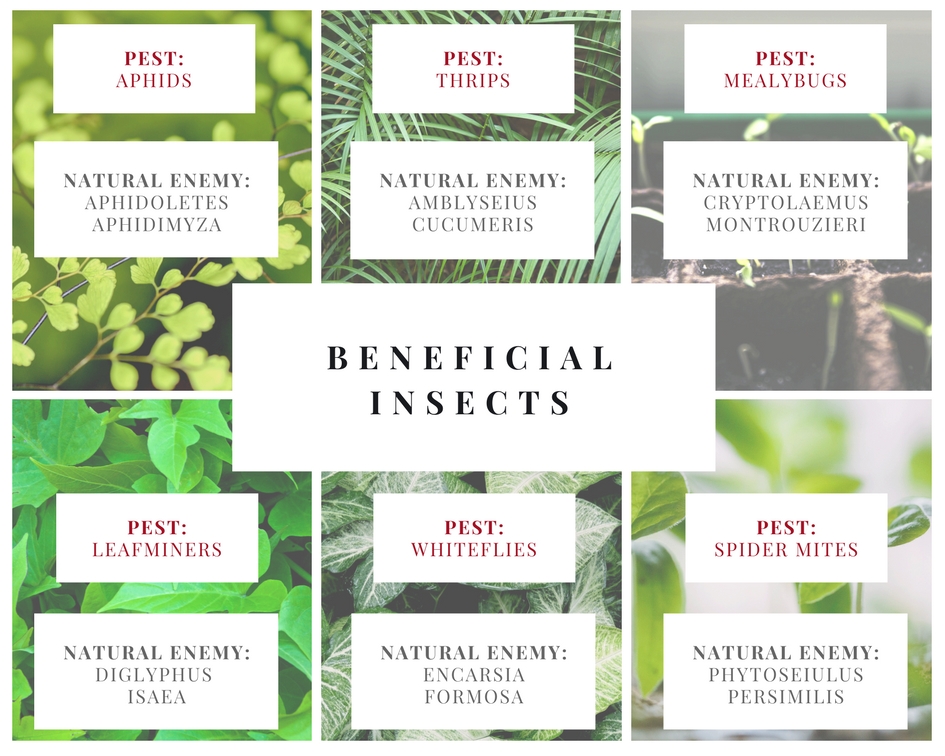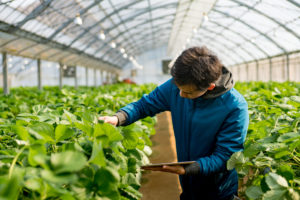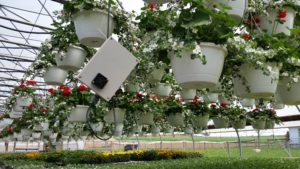How to Create a Greenhouse Disease & Pest Management Program

Many experts say that a successful greenhouse relies on the creation of an Integrated Pest Management (IPM) program. An IPM program uses a variety of methods and techniques to prevent, monitor, and control pests. These programs should be as least hazardous as possible to humans, property, and the environment.
When creating your IPM, Greenhouse Management Magazine recommends that you consider the following factors that contribute to the maintenance of a disease and pest-free greenhouse:
Plant Vulnerability
According to greenhouse crop professionals, you should know when your crops are more susceptible to disease. From mildew and rusts to viruses and root rots, disease can wreak havoc on your plants. It’s important to understand the signs of the most common diseases so you can properly prepare for and treat the conditions.
Plant specialists also suggest that you become aware of the types of insects that may be attracted to specific plant species. To prevent disease, it is recommended that you conduct thorough research on the detrimental pests that may be naturally drawn to your crops. Some of the most common greenhouse pests include:
- Aphids (Plant Lice) — The small, sluggish insects cluster in colonies and tend to multiply rapidly. Curved stems and leaves are common when they’re present.
- Fungus Gnats — While adults can be found on foliage, larvae burrow in the soil and will feed on root hairs, making the plant wilt or grow less vigorously. When full grown, these gnats have small bodies with long legs and clear wings.
- Shore Flies — These flies are similar to fungus gnats but have shorter antennae, red eyes, darker bodies, and smoky wings. They can be observed resting on any surface in the greenhouse and have been known to spread soil pathogens within greenhouses.
- Bloodworms — Boasting a recognizable red coloring, these worms have long bodies and no legs. They frequent areas with standing water or excessive moisture and will feed on any algae or organic matter.
- Thrips — These tiny insects have four wings and a row of long hairs. They are usually found on the plant surface or leaves, and they feed on any exuding sap. They tend to attack azalea, calla lily, cyclamen, cucumber, fuschia, ivy, and rose plants.
- Whiteflies — A more dangerous pest, whiteflies are often resistant to insecticides and require close monitoring to eradicate from greenhouses. They have white, powdery bodies and are most often seen under leaves of fuchsia, poinsettia, cucumber, lettuce, and tomato plants.
- Leafminers — These pests begin damaging plants as larvae, feeding between the outer surfaces of leaves. The leaves will turn light in color and narrow as infestation increases and larvae grow. Once fully grown, the larvae turn into flies that insert eggs into pits in leaf surfaces. Unfortunately, since most of the stages of growth occur within leaves, insecticides aren’t useful at killing or removing leafminers. Hand removal and disposal of infected leaves are recommended.
- Mealybugs — Small and soft-bodied mealybugs feed on plant sap and produce honeydew that creates mold on leaves and stems. They’re often seen attacking croton plants, hoyas, and bamboo palms.
- Two-Spotted Spider Mites — These pests have two black dots on their abdomens, making them easier to identify. They feed on sap on the underside of leaves, resulting in a spotted, yellow, or dry leaf appearance. If an infestation is severe, the plants may be covered in a fine webbing that’s produced by the mite. They are drawn toward marigolds, crotons, chrysanthemums, roses, impatiens, parlor palms, bamboo palms, and ivy.
- Cyclamen Mites — Small and semi-transparent in nature, these mites can attack entire plants or just the plant buds. They can be found on African violets, cyclamen, dahlia, and gloxinia. When an infestation occurs, plant leaves become distorted or curled.
- Slugs & Snails — These pests are attracted to high-humidity climates and frequent leaves, stems, flowers, and roots. Holes in leaves are commonly seen with an infestation.
Greenhouse Sanitation
Many experienced greenhouse growers have found that maintaining a clean greenhouse will allow you to pay more attention to your crops over the growing season. To ensure a smooth and productive growing season, it’s recommended that growers perform these tasks:
- Power wash floors, walls, equipment, and other surfaces.
- Sanitize floors, walls, and irrigation equipment to prevent future greenhouse disease and infestation.
- Sterilize pots that you plan on reusing in bleach.
- Remove weeds.
- Inspect curtains and coverings for signs of wear and aging.
- Dispose of trash and old pesticides.
- Check equipment to make sure everything is running properly.
Using Biological Control (Biocontrol) Agents
Natural and beneficial organisms, known as biological control agents, can be introduced to your greenhouse to fight off and prevent infestation. According to a report by the NC State University Department of Entomology, organisms’ effectiveness can depend on many factors including: climate, reproductive rates, pest life cycles, and the number of pests involved. Due to the large range of factors, additional research should be conducted for specific pests being targeted.
Biocontrol agents help to control infestation naturally, but it takes time for the agents to disperse and search for prey. Due to the delay, it’s recommended that agents be released at the first sign of pests in a greenhouse. If your greenhouse is already heavily infested, experts advise using an insecticidal soap or non-residual insecticide on crops to reduce the number of pests prior to the release of biocontrol agents. However, it’s important to keep in mind that insecticide treatments should be limited. Crop specialists caution that if too many treatments are used, the biological control agents may not be effective.
Let’s take a look at some biological control agents that are commonly used to eliminate greenhouse pests:

Consistent Environment
Since many pests and diseases thrive in hot and humid environments, temperature and humidity are crucial to the success of greenhouses. Experts suggest that one way to control temperature and humidity is by utilizing a natural ventilation system. These systems allow fresh air to move across the width of greenhouses, aiding in temperature and humidity control, air circulation, and CO2/oxygen replacement.
The open-air breeze can benefit plants through transpiration and cell wall strengthening, helping to keep them healthy. Meanwhile, the constant air movement creates uniform conditions throughout the entire greenhouse. With uniform conditions, greenhouse hot spots are wiped out and high humidity percentages are lowered and regulated, terminating the breeding grounds for pests and disease.
Monitoring & Record-keeping
 A Michigan State University AgBio Research report indicates that crop monitoring is crucial when it comes to maintaining a successful greenhouse. It’s recommended that all growers draw up a plan or schedule in order to closely look at specific sections or rows of their greenhouse every single day. To inspect plants, you should turn leaves over and check for discoloration. The report also urges growers to remove plants from their pots and inspect roots for signs of root pathogens. While inspecting, you should be on the lookout for:
A Michigan State University AgBio Research report indicates that crop monitoring is crucial when it comes to maintaining a successful greenhouse. It’s recommended that all growers draw up a plan or schedule in order to closely look at specific sections or rows of their greenhouse every single day. To inspect plants, you should turn leaves over and check for discoloration. The report also urges growers to remove plants from their pots and inspect roots for signs of root pathogens. While inspecting, you should be on the lookout for:
- Spotted or malformed foliage or flowers
- Insects
- Insect skins
- Pockets of dying plants
- Unusual growth or behavior
In addition, it’s suggested that you place yellow, blue, or white sticky traps at plant level to check for activity and identify heavily infested areas. Specific colors aid in the attraction of certain insects. The yellow traps attract thrips, whiteflies, fungus gnats, and winged aphids, while the blue-colored traps mainly draw in thrips. White traps can help detect fungus gnats as full-grown adults. Greenhouse Management Magazine recommends utilizing at least one to two cards per every 500 to 1,000 square feet. The cards should be replaced weekly.
For large-scale management of pests, Greenhouse Canada proposes the use of long sticky tapes to attract and capture insects. They will help reduce infestation, giving you more control over your greenhouse environment.
When treating your greenhouse for disease and pests, it’s advised to place indicators in spots where there is an infestation. You can also use colored stakes to pots to indicate if any plants have been sprayed with growth regulators, insecticides, or fungicides.
Using Automation to Prevent Greenhouse Infestation and Disease
 A modern version of traditional, manual greenhouses, automated greenhouses allow for increased climate control to support and protect crops. With the implementation of motors, sensors, and interface boxes, many daily greenhouse maintenance tasks can occur automatically without the assistance of growers.
A modern version of traditional, manual greenhouses, automated greenhouses allow for increased climate control to support and protect crops. With the implementation of motors, sensors, and interface boxes, many daily greenhouse maintenance tasks can occur automatically without the assistance of growers.
Automated climate controllers electronically control greenhouse components like vent motors and curtain movements. Once set up with the desired programming, climate controllers ensure a consistent temperature and humidity, helping to deter the breeding of pests and diseases.
Climate control isn’t the only benefit to greenhouse automation, though. Our automated ventilation systems utilize:
Superior Reliability
With our lightweight, high torque, low voltage motors, curtain systems operate with fewer moving parts and space requirements than comparable systems. This ensures less mechanical issues over time.
Effortless Quality Control
Ventilation systems, fans, and heaters can be connected to and controlled by one, easy-to-use unit. Timers and sensors, in conjunction with the programming, activate components to maintain the desired greenhouse conditions, aiding the efficiency of the grower.
Increased Energy Efficiency
Thanks to the use of solar controllers, greenhouses can be automated with energy provided by the sun. Not only does it help to cut down on energy costs, solar also provides the added option and convenience of growing in greenhouses in remote locations.
Overall, greenhouses with automation are beneficial in many ways, including managing and preventing plant pests and disease. If you’re looking for a way to reduce labor, save on energy costs, and improve the health of your crops, automation may be the solution you’ve been waiting for.
